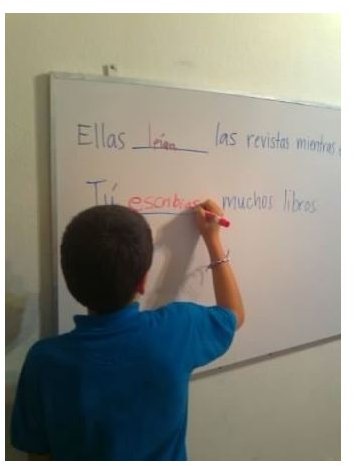Spanish Lesson Plan & Activity on the Imperfect Tense
Differentiating between preterite and imperfect tense can be challenging for even advanced Spanish language learners. Giving students a sound foundation through creative activities will help solidify these past tense concepts. In this lesson plan students will create a song or poem using the imperfect verb tense.
Lesson 4 Objectives:
- Students will become familiar with imperfect tense conjugations for regular verbs with –ar, -er, and –ir endings.
- Students will be able to use imperfect tense verbs in a sentence successfully.
Materials:
- Notebooks
- Pencils
- Paper
Lesson Procedure:
1. Introduction: Write subject pronouns on the board.(i.e. yo, tú, él, ella, usted, nosotros(as), ustedes, ellos(as)). *Note: vosotros(as) may be added in if necessary.
2. Review the ideas that there are two different forms for past tense in Spanish: preterite and imperfect. Review the uses for each tense:
- Preterite: Specific actions that happened in the past with an implied beginning and end- like events on a timeline (i.e. Ella llegó ayer).
- Imperfect: General actions that happened in the past with no definite beginning or ending (i.e. Ellos llegaban de vez en cuando).
3. Create a chart on the board that details the conjugations for each verb ending. Give an example verb for each.
- –ar verbs: -aba, -abas, -aba, -abamos, -aban. (hablaba, hablabas, hablaba, hablábamos, hablaban)
- **–er verbs: -**ía, -ías, -ía, -íamos, -ían. (bebía, bebías, bebía, bebíamos, bebían)
- **–ir verbs: -**ía, -ías, -ía, -íamos, -ían. (vivía, vivías, vivía, vivíamos, vivían)
4. Put sentences on the board and have students come up and conjugate.
- Ellas ______________ (leer) las revistas mientras esperaban. (leían)
- Tú ______________ (escribir) muchos libros. (escribías)
- Nosotros ______________ (asistir) la iglesia los domingos. (asistíamos)
- Yo siempre_________________ (cobrar) la cuota los viernes. (cobraba)
- Usted ________________ (trabajar) en Chicago. (trabajaba)
5. Put students into small groups and have them write a “break-up” song from the point of view of someone remembering what he/she did or where he/she went with that special someone. Offer a prize for the group that was the most creative, included rhyme, created a beat, etc.
6. Have the groups come up and present their song or poem and have the class vote for the best song.
Assessment:
As students are writing their songs/poems, walk around and evaluate student participation to get an idea of who has a good handle on the subject. Assess the students while they present their poem or song on correct verb usage and conjugations.
Asking the students to apply the imperfect tense to a song or poem can help students internalize the correct usage of the imperfect tense. While further study into the imperfect tense is necessary, this fun lesson plan with get students familiar with the basic idea of these verb forms.
This post is part of the series: Teaching the Spanish Verb Tenses
This unit goes through all the Spanish verb tenses: Present, Future, Preterite, Imperfect, and Conditional. These lessons are appropriate for beginner students in grades 8-12.
